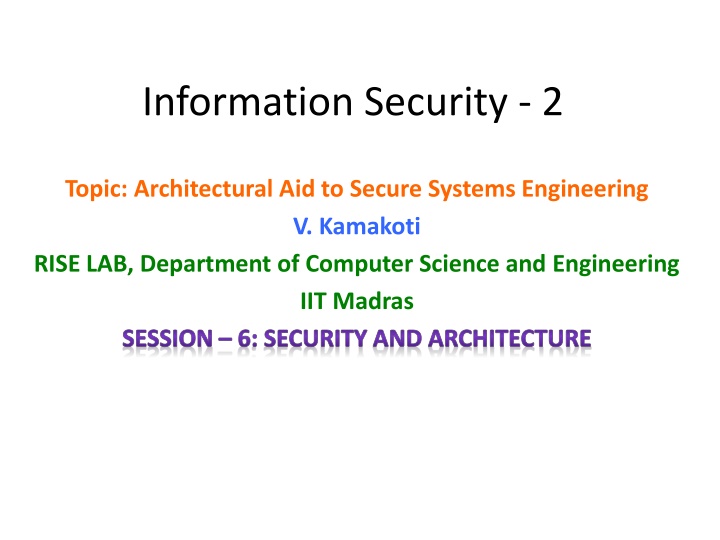
Architectural Aid to Secure Systems Engineering
Explore the intersection of architecture and security in system engineering, discussing the importance of retroactive security measures, memory isolation, hardware security viewpoints, and practical aspects such as developing a Mini Kernel for x86 environments. References to notable works in the field are also provided.
Download Presentation

Please find below an Image/Link to download the presentation.
The content on the website is provided AS IS for your information and personal use only. It may not be sold, licensed, or shared on other websites without obtaining consent from the author. If you encounter any issues during the download, it is possible that the publisher has removed the file from their server.
You are allowed to download the files provided on this website for personal or commercial use, subject to the condition that they are used lawfully. All files are the property of their respective owners.
The content on the website is provided AS IS for your information and personal use only. It may not be sold, licensed, or shared on other websites without obtaining consent from the author.
E N D
Presentation Transcript
Information Security - 2 Topic: Architectural Aid to Secure Systems Engineering V. Kamakoti RISE LAB, Department of Computer Science and Engineering IIT Madras SESSION 6: SECURITY AND ARCHITECTURE
Objectives of this course A solution to these issues A collective effort of Architecture, OS, Compiler and Application Developers Discuss Architecture structure, roles and responsibilities Rest in subsequent courses We have four more in the Information Security series.
Architecture and Security Body and Blood Imagine We existed for four decades with just Body and no blood Suddenly we want to fill up with blood and make ourselves IMMUNE We need several decades RETROFIT SECURITY ROOT of TRUST is Architecture
Security from Hardwares Viewpoint Definition Leakage of Information Unauthorized gain in privilege The Reason Lack of Isolation among programs in execution (Process) Isolation Memory and shared resources
The structure of this course Memory Isolation X86 and ARM Segmentation in x86 Paging in x86 ARM Trustzone Code privilege Interrupt Service in x86 Task/Privilege switching in x86 High Assurance Boot and Secure signing in ARM
Practical Aspects Security is no more theory it is full of practice In this course Develop a Mini Kernel for x86 environment in assembly that help explore the security features provided by x86 hardware. Live demonstration of certain hardware security features in ARM
References Samuel T. King et al., SubVirt: Implementing malware with virtual machines Smashing the Stack for Fun and Profit, aleph1 circa 1996 Paul A. Karger and Roger R. Shell, Thirty Years Later: Lessons from the Multics Security Evaluation.
End of Session-6 Thank You
